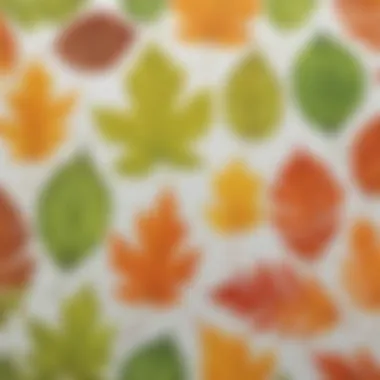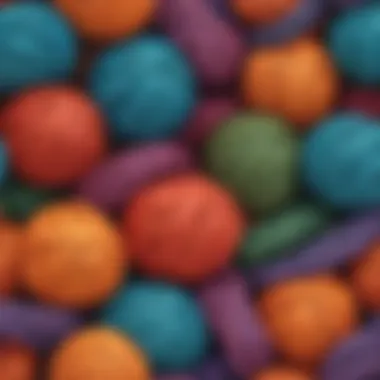Engaging and Educational Easy Art Projects for Preschoolers


Science Fun Facts
Have you ever wondered why mixing colors can create new ones? This seemingly magical phenomenon is due to the way light behaves when it is reflected off different surfaces. When colors mix, they either subtract or add light wavelengths, resulting in the perception of new hues. Preschoolers can experiment with mixing paints to witness this enchanting process firsthand, sparking their curiosity and understanding of color blending. Additionally, did you know that the oldest known painting of an animal was discovered in a cave in Borneo and dates back over 40,000 years? This remarkable piece of history showcases the timeless human inclination towards artistic expression, a trait deeply embedded in our nature. Such fascinating facts can inspire young artists to explore their creativity and appreciation for art.
Discover the Wonders of Science
In the realm of art projects for preschoolers, understanding basic scientific concepts can elevate their creative experience. By introducing simple principles like primary colors, shapes, and textures, children can enhance their artistic skills while grasping fundamental scientific ideas. Utilizing educational videos and animations tailored for young learners can make these concepts even more accessible and engaging. Interactive tools that demonstrate real-life applications of science in art, such as the use of different materials and techniques, provide valuable insights into the interconnectedness of these disciplines. By fostering a connection between science and art, preschoolers can develop a holistic understanding of the world around them, nurturing their curiosity and intelligence.
Science Quiz Time
As young learners delve into the realm of art and science, engaging them with interactive quizzes can reinforce their knowledge in a playful manner. Multiple choice questions themed around art techniques, famous artists, and the properties of various art supplies can test children's understanding while encouraging critical thinking. Brain teasers and puzzles related to art history and creative concepts challenge preschoolers to think outside the box, promoting problem-solving skills and analytical reasoning. By gamifying the learning process through fun and educational quizzes, children can explore the captivating world of art while expanding their cognitive abilities.
Science Experiment Showcase
Embarking on art projects with preschoolers can also incorporate the excitement of scientific experiments, adding a hands-on dimension to their creative journey. From exploring color mixing to creating textured paintings using unconventional materials, fun and engaging experiments can inspire young artists to think innovatively and express themselves freely. Providing step-by-step instructions ensures that children can follow the process independently, cultivating their sense of autonomy and confidence. A detailed materials list helps parents and caregivers gather the necessary supplies, fostering a collaborative environment for artistic exploration. Safety tips and precautions concerning art materials and tools promote a secure and supervised learning environment, prioritizing the well-being of young participants throughout their artistic endeavors.
Introduction
Art projects for preschoolers are not only a source of entertainment but also serve as powerful tools for enhancing early childhood development. In this age group, creative activities like painting, drawing, and collage-making play a crucial role in honing a child's fine motor skills, nurturing their creativity, and boosting their cognitive abilities. These projects lay the foundation for future learning by engaging young minds in fun and interactive ways, making the learning process enjoyable and enriching.
Preschoolers benefit immensely from engaging in various art projects. Since at this tender age, their fine motor skills are still developing, activities that involve hand-eye coordination, such as painting or drawing, can significantly aid in refining these skills. Furthermore, these projects provide an excellent opportunity for children to experiment with different materials, colors, and textures, fostering their creative expression and imaginative thinking.
Moreover, engaging in art projects at a preschool age helps in the development of cognitive abilities. When children are given the freedom to explore their creativity through different art forms, they learn how to think critically, make decisions, and solve problems creatively. These skills are vital for their future academic success and overall cognitive development.
In this article, we will delve into a myriad of easy art projects specially curated for preschoolers. Each section will introduce various projects under painting, collage-making, drawing, and sensory arts, providing step-by-step instructions and valuable insights to make the creative process both enjoyable and educational for young learners.


Benefits of Art for Preschoolers
Art is an essential component of early childhood development, offering a myriad of benefits to preschoolers. Engaging in artistic activities not only fosters creativity but also plays a pivotal role in honing various skills vital for growth. Among the key advantages of art for preschoolers are the development of fine motor skills, encouragement of creativity, and enhancement of cognitive abilities. These aspects form the cornerstone of a well-rounded early education, laying the groundwork for future academic success and holistic well-being.
Development of Fine Motor Skills
One of the primary benefits of engaging in art for preschoolers is the significant development of fine motor skills. Throughout art projects such as painting, drawing, and sculpting, children refine their hand-eye coordination and dexterity. By grasping small objects, manipulating brushes, and controlling coloring tools, preschoolers enhance their precision and control over muscle movements. These activities allow for the fine-tuning of motor skills, leading to improved hand strength and coordination, essential for tasks like writing, buttoning clothes, and tying shoelaces.
Encouragement of Creativity
Art is a beacon of creativity for preschoolers, fostering imagination and self-expression. Through art projects, children are encouraged to explore their boundless creativity, experiment with colors, shapes, and textures, and unleash their artistic flair. This uninhibited creativity nurtures a sense of confidence and self-discovery, empowering preschoolers to think outside the box and embrace originality. By engaging in diverse art forms such as painting, collage, and sculpture, children learn to express their emotions and ideas freely, laying the foundation for innovative thinking and problem-solving skills.
Enhancement of Cognitive Abilities
Embracing art at a young age contributes significantly to the enhancement of cognitive abilities in preschoolers. Engaging in creative activities stimulates brain function, fostering critical thinking, memory retention, and spatial awareness. Through intricate art projects, children sharpen their concentration, observation skills, and attention to detail. The process of conceptualizing, planning, and executing art pieces nurtures cognitive development, promoting intellectual growth and mental agility. Art serves as a medium for preschoolers to explore complex ideas, develop visual-spatial skills, and enhance their overall cognitive capabilities, preparing them for academic challenges and lifelong learning.
Materials Required
Art projects for preschoolers not only fuel creativity but also enhance developmental skills. One crucial aspect of these projects is the materials needed. Choosing the right materials can significantly impact a child's experience and learning. When it comes to materials for these projects, safety is paramount. Opt for non-toxic paints, adhesives, and other supplies to ensure the well-being of the little artists. Additionally, considering the mess that often accompanies art projects, selecting easy-to-clean materials can save both time and frustration. Aprons or old clothes designated for art activities are a wise investment.
Moreover, the quality of materials can influence the outcome of the projects. Invest in sturdy paper that can withstand various techniques like painting, gluing, and cutting without falling apart. High-quality paints and brushes can elevate the finished artwork, offering richer colors and smoother application. Offering a variety of textures within the materials can also enhance sensory exploration for the children. Incorporating items like textured paper, feathers, or even recycled materials can add depth and interest to the projects, stimulating creativity and imagination.
Considering the developmental stage of preschoolers, simplicity is key. Materials that are easy to handle and manipulate encourage independent exploration and creativity. Large beads or crayons are excellent choices for little hands learning to grasp and control tools. Providing materials that offer opportunities for sensory stimulation, such as textured fabrics or colored rice for sensory bins, can further engage young children and enrich their artistic experiences.
Painting Projects


Painting projects play an integral role in the realm of easy art projects designed for preschoolers. These projects serve as a medium of expression, allowing young children to explore their creativity through vibrant colors and different painting techniques. Painting projects not only foster artistic skills but also enhance hand-eye coordination, fine motor skills, and cognitive development in preschool-aged children. It is crucial to introduce painting early on, as it helps children develop a keen eye for detail and improves their ability to focus on tasks effectively.
Finger Painting
Finger painting is a classic art activity that appeals to preschoolers due to its tactile nature and messiness. This particular painting project allows children to engage all their senses while creating unique artworks using their fingers as brushes. The beauty of finger painting lies in its simplicity - it doesn't require any complicated tools, making it accessible and enjoyable for even the youngest children. Through finger painting, preschoolers can experiment with various textures, colors, and patterns, encouraging their sensory exploration and fine motor skill development.
Sponge Painting
Sponge painting is another engaging painting project for preschoolers that offers a different experience from traditional brush painting. By using sponges of different shapes and sizes, children can explore various techniques such as dabbing, stippling, and blending colors. This activity not only enhances children's creativity but also helps them understand color mixing and develop a sense of composition in their artworks. Sponge painting allows children to express themselves artistically in a tactile and playful manner, promoting sensory stimulation and cognitive development.
Bubble Wrap Printing
Bubble wrap printing introduces an element of surprise and excitement to painting projects for preschoolers. By pressing paint-coated bubble wrap onto paper, children can create interesting patterns and textures reminiscent of abstract art. This sensory-rich activity encourages children to experiment with different pressure levels and paint colors, leading to unique and engaging artistic results. Bubble wrap printing not only stimulates children's imagination but also improves their hand strength and coordination as they manipulate the bubble wrap to create prints. This tactile experience fosters a deeper connection between children and art, fostering a love for creativity and self-expression.
Collage Projects
Collage projects hold immense significance in the realm of artistic engagement for preschool-aged children. These projects play a pivotal role in fostering creativity, fine motor skills, and cognitive development in young minds. The tactile nature of collage projects allows children to explore textures, colors, and shapes in a hands-on manner, promoting sensory experiences and imaginative thinking. Moreover, collage projects provide an avenue for children to express themselves artistically, encouraging individuality and self-expression. Parents and caregivers can leverage collage projects as valuable tools to engage children in a stimulating and educational artistic process.
Torn Paper Collage
Torn paper collage stands out as a unique and engaging art form for preschoolers. This creative activity involves tearing or cutting paper into various shapes and sizes, then arranging and pasting them onto a base to create a visually appealing composition. Through torn paper collage, children develop their fine motor skills as they manipulate paper pieces, enhancing hand-eye coordination and dexterity. This project also nurtures children's creativity by allowing them to experiment with different textures, patterns, and colors, fostering artistic exploration and expression. Torn paper collage serves as an excellent introduction to the world of collage art, encouraging young artists to think outside the box and craft imaginative creations.
Nature Collage
Nature collage projects offer preschoolers an opportunity to connect with the natural world while engaging in artistic expression. By incorporating elements such as leaves, twigs, flowers, and other natural materials, children can create exquisite collages that celebrate the beauty of the outdoors. Nature collage not only encourages children to appreciate the environment but also promotes sensory exploration, as they explore the textures, scents, and colors of various natural elements. This art form nurtures a sense of environmental awareness and instills a respect for nature in young learners, enhancing their creative endeavors with a touch of the organic world.


Texture Collage
Texture collage projects introduce preschoolers to the tactile aspects of art, adding a sensory dimension to their creative endeavors. By incorporating materials with different textures, such as fabric scraps, cotton balls, or sandpaper, children can create multi-dimensional collages that stimulate their sense of touch and visual perception. Texture collage not only enhances children's sensory experiences but also encourages them to experiment with contrasting materials to create visual interest and depth in their artwork. This project fosters an appreciation for texture, promoting artistic exploration and tactile sensitivity in young artists as they craft captivating and textured compositions.
Drawing Projects
Leaf Rubbing
Leaf rubbing is a delightful art activity that introduces preschoolers to the wonders of nature through a hands-on approach. In this project, children place a leaf under a piece of paper and then rub over it with crayons or pencils to reveal the leaf's intricate details and textures. Through leaf rubbing, preschoolers can hone their observation skills by examining different leaf shapes, sizes, and vein patterns. This activity not only sparks creativity but also fosters an appreciation for the natural world, making it a perfect blend of art and environmental education for young learners.
Pattern Drawing
Pattern drawing offers preschoolers a structured yet creative outlet for expressing themselves artistically. Through this project, children are encouraged to think about repeating shapes, lines, or colors to create visually engaging patterns. Pattern drawing helps in developing preschoolers' planning skills as they decide on the sequence and arrangement of elements in their artwork. This activity allows children to explore symmetry, practice fine motor control, and experiment with color combinations, facilitating a holistic approach to art appreciation and creation at a young age.
Handprint Art
Handprint art is a tactile and personal art project that enables preschoolers to create unique masterpieces using their own hands. By dipping their hands in paint and pressing them onto paper or other surfaces, children can unleash their creativity and produce one-of-a-kind artworks that showcase their individuality. Handprint art offers an avenue for sensory exploration, as children feel the sensation of the paint on their hands and observe the impressions left behind. This project is not only fun and engaging but also fosters a sense of pride and accomplishment in preschoolers as they see their handprints transformed into colorful works of art.
Sensory Art Projects
Sensory art projects play a crucial role in the development of preschoolers, engaging their senses and fostering creativity. In this section, we delve into the significance of incorporating sensory elements into art activities for young children. By merging art with sensory experiences, children can enhance their cognitive abilities and fine motor skills while having fun. Sensory art projects offer a multidimensional approach to learning, allowing children to explore texture, color, and various materials. These projects stimulate the senses, encouraging curiosity and imagination in young minds.
Shaving Cream Marbling
Shaving cream marbling is a captivating art activity that combines sensory exploration with creativity. This process involves squirting shaving cream onto a flat surface, adding drops of colorful paint, and swirling the colors together with a tool to create stunning marbleized patterns. Children can then press paper onto the marbled shaving cream to transfer the design, resulting in unique artworks. Not only does this project provide a sensory experience through the tactile nature of the shaving cream, but it also allows children to experiment with color mixing and patterns.
Sand Art
Sand art introduces preschoolers to a tactile and visually stimulating form of artistic expression. By layering different colored sand in containers or on adhesive surfaces, children can explore patterns, textures, and colors. Sand art encourages sensory exploration as children feel the texture of the sand and observe how the colors blend together. This hands-on activity promotes creativity and fine motor skills, as children carefully pour and manipulate the sand to create intricate designs. Additionally, sand art offers a sensory experience that engages multiple senses, making it a captivating and enriching art project for young learners.
Playdough Creations
Playdough creations provide an interactive and sensory-rich art experience for preschoolers. Through sculpting, shaping, and molding playdough, children can unleash their imagination and creativity. The soft and pliable nature of playdough enhances sensory exploration as children engage their sense of touch to manipulate the material. This hands-on activity not only promotes fine motor skills but also allows children to experiment with form and structure. Encouraging imaginative play, playdough creations enable preschoolers to express themselves artistically while stimulating their senses in a fun and engaging way.







